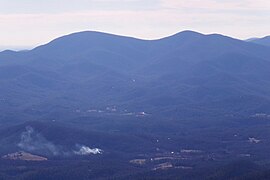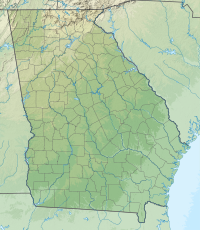Blood Mountain
| Blood Mountain | |
|---|---|
 Blood Mountain (L) and Slaughter Mountain (R), as seen from Brasstown Bald | |
| Highest point | |
| Elevation | 4,452 ft (1,357 m)[1] |
| Prominence | 1,480 ft (450 m)[2] |
| Listing | Mountains of Georgia |
| Coordinates | 34°44′23″N 83°56′14″W / 34.7398487°N 83.9370913°W[1] |
| Geography | |
| Parent range | Blue Ridge Mountains |
| Topo map | USGS Neel Gap[1] |
| Climbing | |
| First ascent | unknown |
| Easiest route | Appalachian Trail, other trails |
Blood Mountain is the highest peak on the
Blood Mountain is the high point of the Apalachicola River watershed via the Chattahoochee River.
History
There are various theories on the origin of the mountain's name. Some believe that the name of the mountain comes from a bloody battle between the
Hiking and recreation

This peak has scenic views from the large rock formations that top the mountain. There is a hiker's shelter at the top of the mountain maintained by the

There is a short (2 mile) but steep (1,800 foot
Adjacent to the mountain are several boulder fields and stands of northern hardwoods and large buckeyes. Portions of the area were previously logged and now sport fast-growing tulip poplar.
Near Blood Mountain are DeSoto Falls Scenic Recreation Area and campground, Vogel State Park and Sosebee Cove Scenic Area. All are accessible from Blood Mountain by trail and road.
Gallery
-
Viewed from the Three Sisters Vineyards
-
Blood mountain historical marker
-
Blood Mountain viewed from Vogel State Park
References
- ^ a b c "Blood Mountain". Geographic Names Information System. United States Geological Survey, United States Department of the Interior. Retrieved 2024-04-24.
- ^ https://www.peakbagger.com/peak.aspx?pid=7737
- ^ Prats, J.J., ed. (2007-11-01). "Blood Mountain". The Historical Marker Database. Retrieved 2008-01-09.
- ^ a b Brown (1996), p.93
- ^ Perry, Tristan. Ghostly Legends of the Appalachian Trail. Wever, Iowa: Quixote Press, 2008. Pages 63-76.
- ^ "Weekly list of actions taken on properties: 1/07/13 through 1/11/13". National Park Service. January 7, 2013. Retrieved February 16, 2013.
- ^ a b Brown (1996), p. 94
- ^ Brown (1996), pp. 93-94.
- Brown, Fred (1996). The Georgia Conservancy's Guide to The North Georgia Mountains (3rd ed.). Atlanta: Longstreet Press. ISBN 1-56352-314-0.
- Tucker, Margaret. "A Winter Hike on Blood Mountain." Reprinted in Brown's Guide to the Georgia Outdoors, John W. English, ed. Atlanta: 1986, Cherokee Publishing. ISBN 0-87797-128-5
- Georgia's Named Summits
- 100 highest peaks in Georgia
- Georgia peaks over 4,000 feet (1,200 m)




